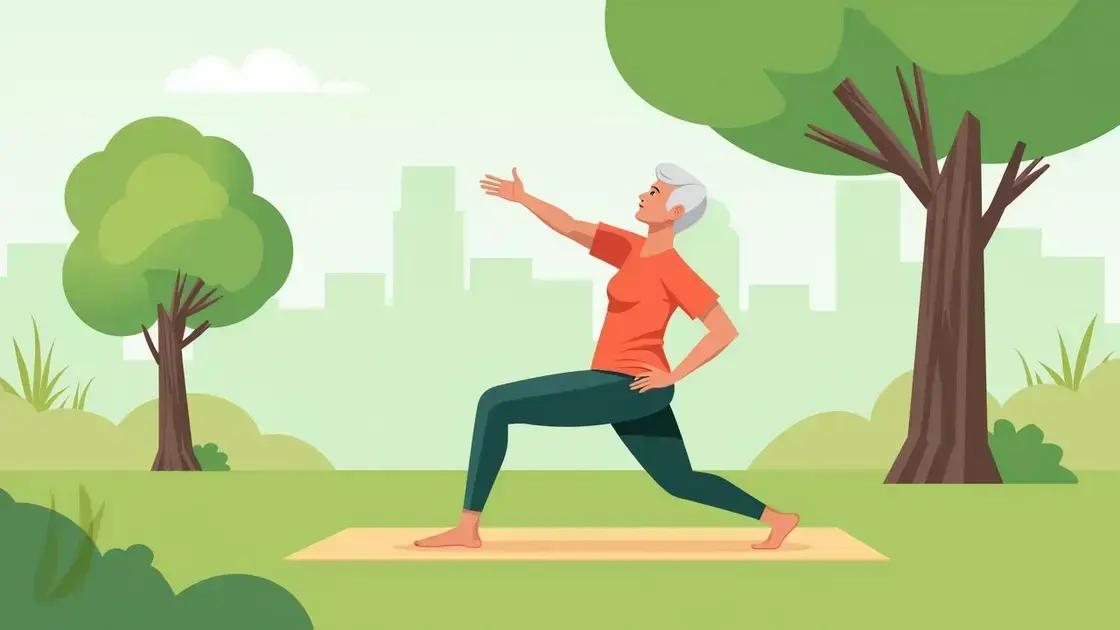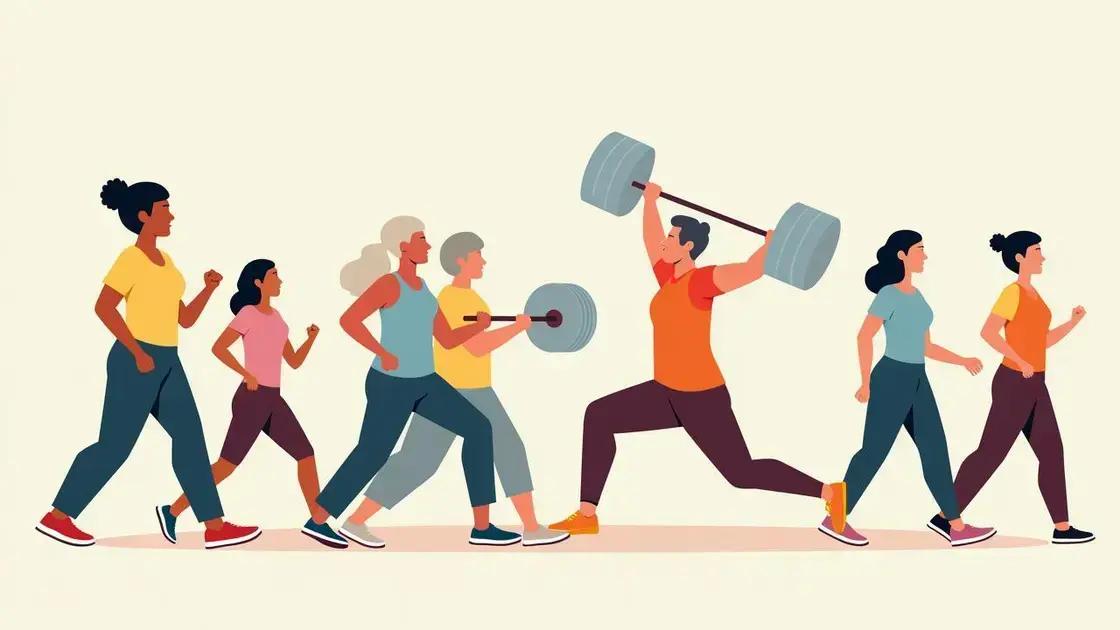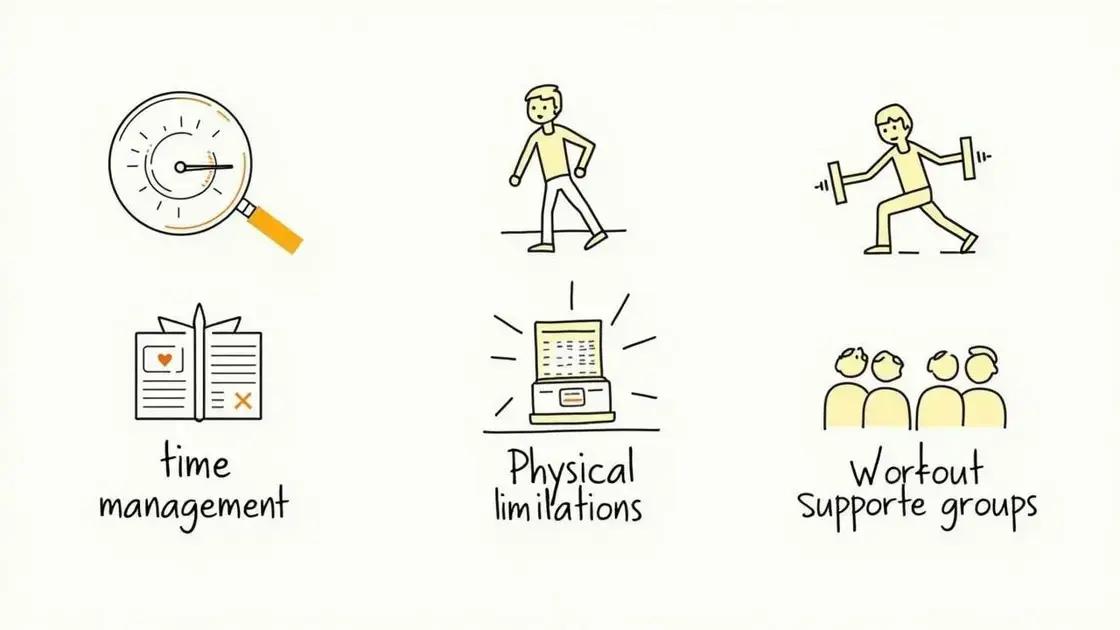Setting realistic fitness goals in your 50s involves understanding physical changes, creating SMART goals, tackling common challenges, and tracking progress effectively to maintain motivation. By starting small and adopting a balanced approach to fitness, you can achieve and sustain a healthier lifestyle.
Setting realistic fitness goals in your 50s is crucial for maintaining health and well-being. As we age, our bodies change, making it essential to adapt our fitness goals to new realities. This article will guide you through understanding fitness in your 50s, enabling you to set achievable fitness goals while addressing common challenges. With proper strategies, tracking your progress, and maintaining motivation, you can lead a healthier life.
Understanding Fitness in Your 50s

Understanding fitness in your 50s is essential for maintaining a healthy lifestyle. At this age, our bodies undergo several changes that may affect our strength, flexibility, and endurance. Awareness of these changes allows you to tailor your fitness journey effectively.
Physical Changes
As we age, factors such as metabolism, hormonal changes, and muscle mass loss begin to take place. A decrease in metabolism can make it easier to gain weight, while hormonal shifts might affect energy levels. Muscle mass typically diminishes by roughly 1% per year after the age of 30, which can impact both strength and stamina.
Importance of Exercise
Regular exercise becomes increasingly vital in your 50s. Engaging in physical activity not only helps to manage weight but also strengthens bones and improves cardiovascular health. Incorporating a mix of strength training, aerobic exercises, and flexibility routines can provide a well-rounded approach to fitness.
Setting Realistic Expectations
It’s essential to set realistic expectations for your fitness program. Understand that recovery times may increase, and it’s crucial to listen to your body. Start with manageable goals, gradually increasing the intensity and duration of your workouts.
Consulting Professionals
Before beginning any fitness program, it’s wise to consult a healthcare provider or fitness professional. They can help assess your current health condition and provide recommendations tailored to your unique needs and capabilities.
Emphasizing a balanced approach to fitness in your 50s will not only enhance your physical health but also contribute positively to mental well-being, leading to a fulfilling lifestyle.
Setting Achievable Fitness Goals

Setting achievable fitness goals is essential for success, especially in your 50s. Goals should be clear, realistic, and tailored to your current fitness level. This helps maintain motivation and encourages consistency in your fitness journey.
SMART Goals
Use the SMART criteria when establishing fitness goals. SMART stands for Specific, Measurable, Achievable, Relevant, and Time-bound. For example, rather than saying “I want to get fit,” a SMART goal would be, “I will walk for 30 minutes, five days a week, for the next three months.”
Start Small
Begin with small, manageable changes. Setting small goals can lead to big results over time. Focus on building a routine that fits well within your lifestyle, such as adding a short walk after dinner or incorporating simple strength exercises twice a week.
Focus on Different Areas
Consider balancing your goals across various aspects of fitness, including cardiovascular endurance, strength, flexibility, and balance. For instance, aim to complete a 15-minute stretching session each day to improve flexibility while also setting a target to join a local exercise class.
Adjust as Needed
Be prepared to adjust your goals based on your progress and any challenges you encounter. Life can be unpredictable, and flexibility in your goals is vital. If you find an exercise too challenging, modify it or pick a new activity that excites you. Always listen to your body and make adjustments that support your health.
By setting achievable fitness goals, you create a path to success that is both motivating and sustainable as you navigate your fitness journey in your 50s.
Common Challenges and Solutions

Common challenges come with setting fitness goals in your 50s, but there are solutions to help overcome them. Recognizing these obstacles can make a significant difference in achieving your fitness objectives.
Time Constraints
Many people in their 50s juggle work, family, and other responsibilities, which can make finding time for exercise difficult. To address this, consider planning shorter workout sessions that fit into your schedule. Aim for 10-15 minutes of activity throughout the day, such as a brisk walk during lunch breaks or stretching while watching TV.
Motivation Issues
Staying motivated can be challenging, especially if you don’t see quick results. To combat this, set mini-goals that celebrate small achievements along the way. Engage with friends or join a fitness group to create a supportive environment that encourages accountability and fun.
Physical Limitations
Physical challenges like joint pain or reduced mobility can hinder your ability to exercise. Consultation with a healthcare professional can help identify safe activities. Consider low-impact exercises such as swimming, biking, or yoga, which can improve strength and flexibility without excessive strain.
Plateaus in Progress
Experiencing a plateau in your fitness journey is common and can be frustrating. To break through plateaus, vary your routine by trying new activities or increasing the intensity of your workouts. Incorporating strength training or interval training can also help to shake things up and promote further progress.
By understanding these common challenges and applying practical solutions, you can successfully set and achieve realistic fitness goals as you navigate your 50s.
Tracking Your Progress and Staying Motivated
![]()
Tracking your progress and staying motivated are key components of achieving your fitness goals in your 50s. Monitoring how far you’ve come can provide the encouragement needed to keep going.
Keeping a Fitness Journal
A fitness journal is a great way to track your workouts and progress. Write down your exercises, duration, and how you felt during each session. This not only helps you see your improvement over time but also allows you to identify what works best for you.
Using Fitness Apps and Devices
Consider using fitness apps or wearable devices to help monitor your activities. These tools can track steps, calories burned, and even your heart rate. Many apps allow you to set reminders to exercise, helping to keep you accountable and on track.
Setting Checkpoints
Set regular checkpoints to evaluate your goals. For example, every month, review your fitness achievements, and make any necessary adjustments to your routine. This regular assessment helps ensure you remain focused and motivated.
The Role of Social Support
Engaging with friends or joining support groups can boost your motivation significantly. Share your goals and progress with others. Their encouragement can help you stay committed and make your fitness journey more enjoyable.
By actively tracking your progress and utilizing various strategies for motivation, you can create a sustainable fitness plan that promotes long-term success in your 50s.
Achieving Realistic Fitness Goals in Your 50s
Setting and achieving realistic fitness goals in your 50s is not only possible but can also lead to a healthier, more fulfilling lifestyle. By understanding the physical changes that come with age, setting achievable goals, and preparing for common challenges, you can create a sustainable fitness routine.
Tracking your progress and staying motivated through tools, social support, and regular evaluations further enhances your journey. Remember, consistency is key, and every small step contributes to significant long-term benefits.
Embracing this journey equips you to enjoy a vibrant and active life well into your later years. Prioritize your health, and make your fitness goals a reality!
FAQ – Frequently Asked Questions about Setting Realistic Fitness Goals in Your 50s
What are realistic fitness goals for someone in their 50s?
Realistic fitness goals can include aiming to walk 30 minutes a day, attending a weekly exercise class, or engaging in strength training twice a week.
How can I track my fitness progress effectively?
You can track progress using a fitness journal, fitness apps, or wearable devices that monitor your activities, steps, and calories burned.
What should I do if I face physical limitations while exercising?
Consult a healthcare provider for safe exercise options, like low-impact activities such as swimming, yoga, or walking that can accommodate your limitations.
How can I stay motivated to exercise regularly?
Stay motivated by setting small, achievable goals, tracking your progress, and engaging with friends or fitness groups for support and encouragement.
What are common challenges when trying to get fit in your 50s?
Common challenges include time constraints, motivation issues, physical limitations, and plateaus in progress; identifying these helps in finding solutions.
Is it important to consult a professional before starting a fitness regimen?
Yes, consulting with a healthcare provider or fitness professional ensures that your workout plan is appropriate and safe based on your individual health needs.












